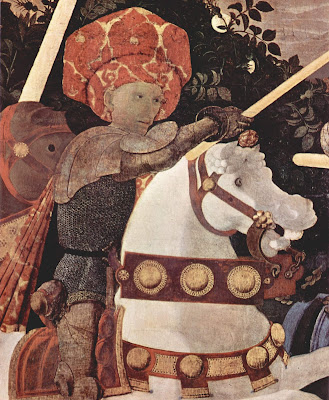In paint, the old ways can be the most dangerous.
 |
|
Sketch for ‘The Hay Wain’ c.1820, oil on paper on panel, John Constable, courtesy the Yale Center for British Art |
In most disciplines, ‘all-natural’ evokes the idea that something is made of pure, safe, wholesome materials, better for us and the environment than the products of a chemistry lab. That may be true of food, although in America, the “all-natural” label means little or nothing.
In paint, ‘all-natural’ can be a very bad label indeed. The pigments drawn directly from the earth are sometimes the most dangerous ones on the palette.
We know what John Constable’s palette contained, because the artist died unexpectedly in 1837, leaving behind four wooden palettes, a wooden sketching box with brushes, chalk holder, palette knife and pigments in glass phials. There was also a wooden box full of pigments, and a metal field-painting box.
 |
|
Constable’s metal paint box c.1837, courtesy of the Tate |
This box contains eleven paint bladders, a piece of white gypsum and a glass bottle of blue pigment. Constable could have purchased these paints pre-mixed, or mixed the pigments and poppy-seed oil binder himself. Since the paint tube hadn’t been invented yet, the mixed pigments were stored in pig’s bladders tied at the top with twine.
Constable was very forward-looking in terms of technique and materials. He popularized plein air painting, and brought respectability to landscape painting. In a milieu where smooth paint application was a primary virtue, he was flicking colors on with a palette knife.
In one respect, though, he was a traditionalist: he persisted in using ground lazurite instead of synthesized ultramarine. He believed that the natural pigment had a better color range than its synthetic analogue.
In Constable’s paint box were:
Chrome yellow
Yellow ochre
Vermillion
Red madder
Cobalt blue
Prussian blue
Emerald green
Raw sienna
Burnt sienna
Flake (lead) white
Lamp black
Sienna, ochre and umber are the oldest pigments known to mankind, going back to prehistory. All of them are based on iron oxide. They differ in color depending on how much manganese is present and how long they’ve been cooked. They are absolutely safe pigments.
 |
|
Woman Embroidering, 1812, by Georg Friedrich Kersting, courtesy Kunsthalle Kiel. The 19th century craze for copper-arsenite greens was a health disaster among the fashionable. |
But others on Constable’s palette are not so benign. Chrome yellow, along with Naples yellow and flake white, are banned from the modern paintbox because they’re lead-based. Vermillion is made from the mineral cinnabar, which contains toxic levels of mercury. All are absolutely natural—and absolutely deadly.
Constable’s cobalt blue was probably ground glass (smalt). In that form cobalt is benign, but the pigment itself is toxic. And emerald green is copper-acetoarsinite, which in addition to use as a pigment, made a good rodenticide and insecticide. That color, fashionable in the 19th century, was the root of countless deaths from arsenic poisoning, and is posited as the cause of Napoleon’s stomach cancer. Even the innocuous-sounding ‘lamp black’ wasn’t as innocent as its name implies. It was made of soot, which is an inhalation carcinogen.
 |
|
The Battle of San Romano, 1438, Paolo Uccello, courtesy National Gallery. In addition to being toxic, vermillion darkens over time. The horse’s bridle was originally bright red. |
Plant and animal pigments are generally not toxic, but they’re not light-fast, either. Red madder was an extract of Rubia tinctorum, the same pigment source as natural alizarin crimson. The synthetic analogues are cheaper and more stable.
The carmine (crimson) of antiquity was extracted from an insect, Kermes vermilio, which lives on oak trees in the Mediterranean basin. Unfortunately, carmine and its close cousin cochineal fade rapidly on exposure to sunlight. That’s not a problem if you’re making food coloring, but it is a problem when you use it for paint.
Most modern pigments were first designed to be used in industrial settings, not for painting. Because of this, they must be light-fast and safe to use in large quantities. An example is phthalo blue, used widely in the printing industry. It’s cheap, plentiful, and not known to be toxic to man or animal.
